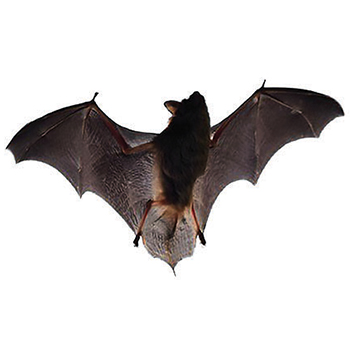Maryland Bat Control

If you own a home or business in Maryland, protecting it from pests is an important part of ongoing maintenance. While important for ecological balance and legally protected, bats nevertheless can pose a serious threat to human health if allowed to reside in homes or businesses. To protect your Maryland home or business from bats, you need to learn about the behavior of this pest, take steps for prevention, and find effective and humane exclusion options should an infestation occur.
What is a Bat?
Bats are small, nocturnal mammals with winged forelimbs, and are the only mammal capable of true flight. The Maryland bat control experts at Viking Pest explain despite appearances, bats are not rodents, and they are usually not blind. There are 1240 species of bat on Earth, 10 of which are found in Maryland. The most common of these seen in houses and businesses are the little brown bat and the big brown bat.
In nature, these bats roost during the day in hollow trees or caves, but when they come in contact with urban areas, they often choose attic spaces, windows, storm drains, and other similar man-made structures. In Maryland, all bat species are of the Microchiroptera group, which means they eat insects like mosquitoes, stink bugs, moths, and others. Of the 10 bat species native to Maryland, four tend to migrate in winter or hibernate in trees, and six are considered cave bats, meaning they prefer caves or tunnels. The Maryland bat control experts at Viking Pest explain both the little brown bat and the big brown bat are cave bats, which is why they’re seen more often in buildings.
How to Identify a Bat?
Wildlife control experts in Maryland state bats, in general, are identifiable by their long ears and unique wings, which unlike a bird’s are made up of spread appendages (“fingers”) covered by a thin skin-like membrane. Little brown bats are small – only two and a half to four inches long as adults. These tiny bats have dark brown, glossy fur on their backs and grayish fur underneath. Big brown bats are near twice the size of little brown bats, at four to five inches long. These common bats have long, silky fur that appears chocolate brown in color and broader noses than little brown bats. Brown bats have dark to black faces and wings, with wingspans of up to 13 inches. Other species you may encounter include the Eastern Red Bat, the Eastern Small-Footed Bat, and the Northern Long-Eared Bat, among others.
When are Bats Present in Maryland?
Bats are mainly active in the spring and summer months than in the cold winter months. Most bat species either migrate away in the Winter or hibernate. The big brown bat is the only species known to overwinter in homes or businesses in Maryland.
How to Control Bats in Maryland?
The Maryland wildlife control experts at Viking Pest explain since bats are a protected species and Maryland’s bat populations are considered species of greatest conservation need, controlling bats in Maryland is regulated. It’s not allowed to exterminate bat colonies or individuals in Maryland, so the only effective and safe treatment in Maryland for a bat infestation is humane exclusion. Exclusion of bats is a matter of letting bats get out of your home or business and not back in, and there are certain times of the year it is not recommended. Viking Pest performs bat exclusion service April 1- April 30 and August 1- October 15.
The best way to get rid of bats, whether they’ve taken up permanent residence or have just wandered into your Maryland home or business, is to call the Maryland bat control experts at Viking Pest. Viking Pest Control will help inspect the exterior and interior of your home or business for signs of bats, including entry points and bat guano (droppings). If evidence is found, Viking Pest can help you install one-way doors for proper human bat exclusion in Maryland.
Bat Exclusion During Maternity Season
Bat exclusion can legally be performed April 1 – 30 and August 1 – October 15 as stated by the NJ Division of Fish and Wildlife. These guidelines protect bats and people by ensuring exclusion is done effectively, working with the bats’ natural rhythms. Performing exclusion work outside of these windows is more likely to result in bats getting into your living space and/or cause illegal harm to the animals. If bats are invading your home outside of the legal exclusion window, please read below.
- Our wildlife control experts can block openings between the bats’ roost and human living areas (i.e. the space beneath the attic door, holes in ceilings or walls, etc.) at any time of year since doing so will not disturb or trap bats. This is a preventative measure to keep bats from coming into contact with people or pets inside the home.
- For health-related concerns, residents should contact their local health department.
- You can find more info on the NJ Division of Fish and Wildlife Bat Conservation webpage and Bats in Buildings page.
As always, free bat houses are available to customers who’d like to give their bat colony a new place to roost – contact Viking Pest today if you would like to reserve a FREE bat house for your home.
Can Bats Spread COVID-19?
People cannot contract COVID-19/SARS-CoV-2 virus from bats.
Protecting Your Maryland Home or Business in Maryland from Bats with Viking Pest Control
Viking Pest offers expert treatment designed to effectively and efficiently control and prevent bats from invading your home or business in Maryland. Our use of Integrated Pest Management (IPM) techniques focuses on finding the core of the pest concern and controlling bats from the source. Through IPM, pest control materials are selected and applied in a manner that minimizes risks to human health, pets, and the environment. Call Viking today for your FREE and NO OBLIGATION estimate at 1-800-618-2847 or schedule online today!














